 |
 Chemical
Conservation Chemical
Conservation
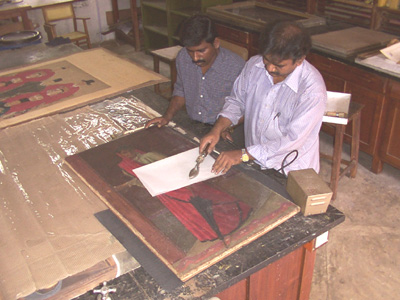 |
History of the
Laboratory
With the valuable collection at the Government Museum, Chennai, it was
felt necessary to treat the bronze icons disfigured by corrosive crusts in order to expose the
decorative details and to eliminate the bronze disease, which brought in added deterioration. As a
result of the discussion with various chemists, the electrolytic restoration of bronzes was
started in the museum. The Chemical Conservation and Research Laboratory in the museum owes to the
scientific vision and foresight of Dr. F. H. Gravely, Superintendent of the Government Museum,
Chennai in the early 1930s. Dr. S. Paramasivan was appointed as the Chemist in 1930. He was very
active both in conservation and research activities. Besides the treatment of bronze objects,
ethnological, prehistoric and numismatic objects were treated. In 1935, the Government Museum,
Chennai was also of help to Archaeological Survey of India in the examination of wall paintings at
Thanjavur, Sittannavasal etc.
In 1937, a separate Chemical Conservation Laboratory Block ( Old
Chemistry Block ) was built, being the only one of its kind in India. A two storied building for
the Laboratory was constructed in 1963 during the Curatorship of Mr.N.Harinarayana. He was
Instrumental for outreach conservation activities, research and a course on Care of Museum
Objects. In 1997, the Chemical Conversation and Research Laboratory was recognised as a research
institution to conduct research leading to Ph. D. Degree during the Curatorship of Dr.V.Jeyaraj.
Research Activities
One of the foremost activities of the Laboratory is to conduct research
in conservation and materials of the past. In the beginning much research was conducted by Dr. S.
Paramasivan, the first Curator of the Laboratory, on paintings and metallic antiquities. The
research findings were published in leading scientific journals both in India and abroad. The
research activities continued successfully by the Curators of the Laboratory till date. At present
research projects such as Fingerprinting of South Indian Bronze Icons, Holographying Museum
Antiquities, Survey of Monuments in Tamil Nadu, Conservation of Metallic Antiquities etc. are
under progress. |
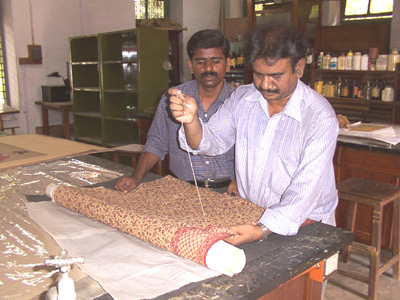 |
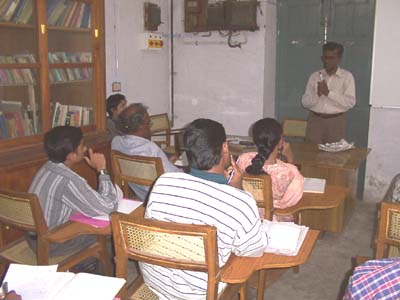
|
Conservation Research Activities
The Laboratory is interested in the conservation research in order to
find out new techniques and materials in collaboration with leading research institutions such as
Indira Gandhi Centre for Atomic Research, Kalpakkam; Indian institute of Technology, Chennai; Anna
University, Chennai and foreign institutions like the Australian Museum, Sydney, Australia. The
Laboratory was recognised as a research institution in 1997 by the Madras University to conduct
research leading to Ph. D. Degree. Dr. V. Jeyaraj, Curator of the Laboratory is a recognised
research guide. At present two part time and one full-time research scholars are working on
research projects Viz. Conservation of Thanjavur Paintings, Wall Paintings, Technical Study of
Chola Coins.
Publications
The publication of this Laboratory from its inception is commendable.
Leading national and international journals such as Indian Academy of Sciences, The Current
Science, Conservation of Cultural Property in India, Studies in Conservation, Technical Studies,
etc., published the out come of the research works of this Laboratory. Besides hundreds of
research and popular articles many books and bulletins have been published. Handbook on
Conservation in Museums, Care of Museum Objects, Conservation of Archival Materials, An
Introduction to the Chemical Conservation and Research Laboratory, Care of Archival Materials,
Conservation of Temple Objects, Conservation of Cultural Property in India, Care of Paintings
etc., are some of its publications. Many conservation reports have been prepared by the successive
Curators regularly through out the career of this Laboratory.
Training
In order to disseminate the expertise of the Laboratory, in 1974, a
refresher course on Care of Museum Objects was started by Mr.N.Harinarayana the then Curator.
Professionals and students of museology and related subjects received the training. Course on Care
of Temple Antiquities for the Executive Officers of the Hindu Religious and Charitable Endowments
Department, Government of Tamil Nadu, Chennai, a course on Care of Archival Materials exclusively
for the Archivists, a Course on Care of Library Materials for Librarians, a Course on Care of Art
Objects exclusively for art students etc. are conducted. Besides these, training programmes to the
school and college students are conducted both in Chennai and districts on Care of Cultural
Materials and Preservation of Monuments. It has introduced internship training in Conservation for
a period of one year.
Conservation Service
The Laboratory is extending services to the public and other institutions
interested in the preservation of objects of the past at nominal charges. The Laboratory is not
able to meet the requirements of the Museum as well as the outside demand due to want of staff in
the Laboratory. On request, the Curator delivers lectures on conservation in order to popularise
the subject.
|
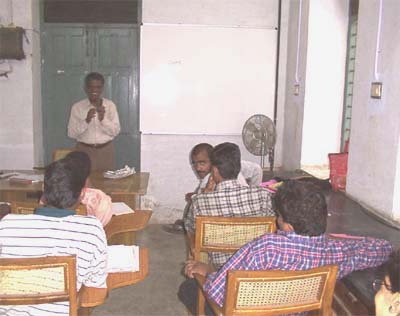
|
| 
|
Conservation Gallery
For the first time in India, the Chemical Conservation and Research
Laboratory of the Chennai Museum has set up the Chemical Conservation Gallery in the Museum in
order to educate the visiting public on the preservation of the cultural and artistic heritage of
our county.
Staff
The Chennai Museum is a multidisciplinary museum having over two lakhs of
objects and about 5% of them are in need of conservation treatment. Three members of staff man the
Laboratory. One volunteer is helping in the laboratory's work.

|
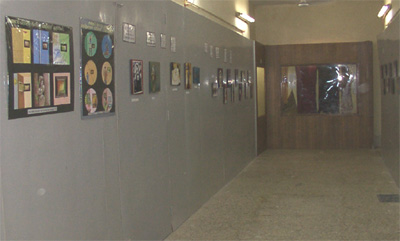
|
|

Course on Conservation for Archaeologists, Museologists and officers of the
Hindu Temples Administrating Departments (HR&CE ), run mainly with a view to providing an
alternative to sandblasting as a method of cleaning walls and sculptures in Temples. |
|
|

Training to Idol wing, Police personnel in identifying antiques especially bronzes and sculptures.
|
|
 Way
to the Gallery Way
to the Gallery |
|
|

|
|